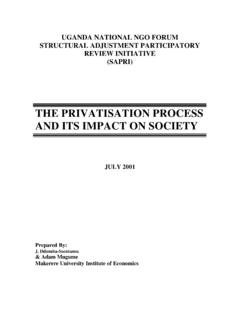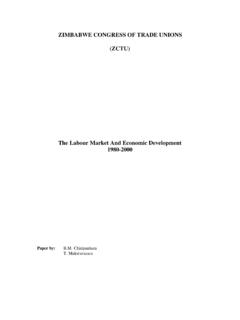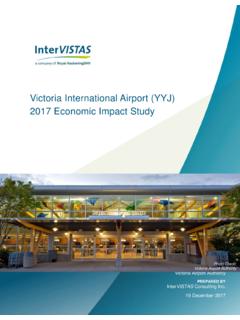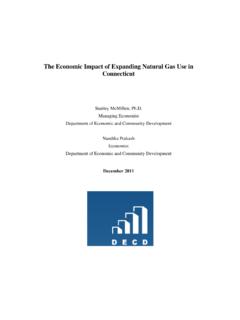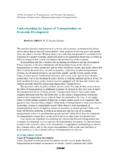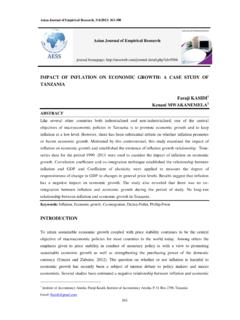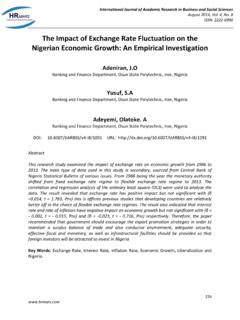Transcription of TRADE LIBERALISATION UNDER STRUCTURAL ECONOMIC …
1 Final Draft TRADE LIBERALISATION UNDER STRUCTURAL ECONOMIC ADJUSTMENT impact ON SOCIAL WELFARE IN ZIMBABWE PAPER FOR THE POVERTY REDUCTION FORUM [PRF] STRUCTURAL ADJUSTMENT PROGRAM REVIEW INITIATIVE [SAPRI] By Moses Tekere Director- TRADE and Development Studies Centre [TRADES CENTRE] Lecturer Department of Economics University of Zimbabwe Email; Date April 2001 2 TABLE of CONTENTS 1 Background of TRADE LIBERALISATION in Zimbabwe Wedded to the Washington Consensus neo-liberal TRADE reasoning Zimbabwe s TRADE LIBERALISATION Program ESAP and ZIMPREST 2 TRADE LIBERALISATION and ECONOMIC Performance Was ECONOMIC growth better before or during the reform period Agriculture apparent winner from LIBERALISATION Mining driven ECONOMIC growth a shattered dream Manufacturing the main casualty of TRADE LIBERALISATION 3 Zimbabwe and Competition in world markets Where does Zimbabwe have revealed comparative advantage?
2 Which are Zimbabwe s rising and falling stars? Immesiring growth - deterioration of prices of commodity exports 4 Informalisation of TRADE - the case of informal Cross Border TRADE Informal cross border TRADE - a survival technique New Trends in informal Cross Border TRADE Informal Cross-Border TRADE more positive than negative impact Problems with Informal Cross-Border TRADE 5 Some sub-sectoral Case Studies on the impact of TRADE LIBERALISATION Woodwork and Furniture More gains than loses Textile and clothing Losses and loses Craft unique but spaghetti outcome Metal work lost opportunities 6 Distributional dimensions of TRADE LIBERALISATION Effects on Customers Effects on Gender Effects of Labour More jobs were lost than created Who are Causalities of TRADE LIBERALISATION From
3 Formal to informal employment Blame thy Neighbour broadening of social conflicts 7 Rethinking TRADE LIBERALISATION TRADE Policy Reversal 8 Conclusion 9 Literature ANNEX A Zimbabwe s Multilateral, Regional and Bilateral TRADE Arrangements 1 World TRADE Organisation (WTO) Costs and Benefits from Implementing WTO Provisions Proposals to enhance benefits from WTO 2 Lome Convention and Post Lome IV ACP-EU Cupertino 3 SADC & COMESA 4 Bilateral TRADE agreements Agreement with South Africa impact of SA_EU Free TRADE Agreement on Zimbabwe Agreements with Botswana and Namibia 3 Acronyms ACP African, Caribbean and Pacific Countries CFU Commercial Farmers Union CMB Cotton Marketing Board COMESA Common Market for Eastern and Southern Africa CSC Cold Storage Commission DMB Dairy Marketing Board ESAP ECONOMIC STRUCTURAL Adjustment Program EU European Union GDP Gross Domestic Product GMB Grain Marketing Board ILO International Labour Organisation IMF International Monetary Fund MFA Multi Fibre Agreement MFN Most Favoured Nation OGIL Open General Import License RPED Regional Enterprise Development program SA South Africa SADC Southern African Development Community WTO World TRADE Organisation ZCTU Zimbabwe Congress of TRADE Union ZFU Zimbabwe Farmers Union ZIMPREST
4 Zimbabwe Program for ECONOMIC and Social Transformation 4 1 Background to TRADE LIBERALISATION in Zimbabwe Kakara Kununa Hudya Kamwe - [A predator thrives on preying on other animals]- Shona Proverb defining TRADE LIBERALISATION by ordinary Zimbabweans Wedded to the Washington Consensus- neo liberal TRADE reasoning TRADE LIBERALISATION is one of the key elements of ECONOMIC STRUCTURAL adjustment packages sold to developing countries by the Bretton woods institutions, the WTO, bilateral and multilateral donors. It lies at the heart of the New Washington Consensus and has long been championed as the panacea to low ECONOMIC growth being experienced in developing countries. Achievements of South East Asia strongly support the view that export led growth policies serve as an engine for enhancing social welfare, human development, ECONOMIC growth and development as well as serving as a mode for greater integration of these countries into the global economy.
5 UNCTAD [1996, 1998] and World Bank [1994, 1997]. Contrary to such experience, and particularly in Africa, there is no conclusive evidence regarding the role and impact of TRADE LIBERALISATION and globalisation on human development, livelihoods, social welfare and ECONOMIC development. Few African countries have benefited from TRADE LIBERALISATION [World Bank 1995, 1996b] while in a number of cases, LIBERALISATION was followed by misery, increased hardships, deterioration of human development, destruction of poor peoples livelihoods, environment, high rates of inequality, marginalisation of poor countries and their communities. Notwithstanding the controversy regarding the role of TRADE LIBERALISATION on ECONOMIC development, and social welfare, the momentum of TRADE LIBERALISATION continues in Zimbabwe.
6 Since 1991, Zimbabwe undertook unilateral measures to liberalise its TRADE regime within the context of ESAP with assistance from Bretton Woods institutions which was followed by further LIBERALISATION within the multilateral [WTO] context, regional framework [SADC, COMESA] as well as at bilateral level. Currently, Zimbabwe is in its second phase of TRADE LIBERALISATION within ZIMPREST the successor program to ESAP and also within the new WTO TRADE negotiations round, Lome Convention, SADC and COMESA. Neo-liberal ECONOMIC reasoning justifies LIBERALISATION of TRADE on the premise that it creates opportunities for firms to grow through better access to new production technologies, inputs, managerial and administrative skills and market information to local producers.
7 Competition from imports lead to specialisation, efficient allocation of resources and cleanse the economy of inefficient producers which removes the burden on the society of sustaining such entities. With greater openness, small economies tend to have higher shares of TRADE in their GNP when compared to large countries and their gains from TRADE are most likely to be higher than those nations that restrict TRADE , Kuznets [1973]. Further, TRADE LIBERALISATION enhances welfare of consumers and reduces poverty since consumers will have opportunities to choose over a wide variety of better quality and cheaper imports. In other words, TRADE LIBERALISATION is a means towards enhancing human development, social welfare and sustainable ECONOMIC growth and development.
8 However, the TRADE and welfare benefits nexus is not automatic but dependent on several factors such as sequencing and phasing of LIBERALISATION as well as built-in mechanisms to distribute benefits. Critics of conventional TRADE theory and wisdom argue that the world trading environment is grossly uneven, characterised by unequal exchange, transfer pricing practices, price manipulation by monopolies, imperfect competition and cross conditionalities, Singer- Prebisch, [1970s], Martin Chore. [1998], Lal, Das, [1998] and UNDP [1999]. UNDER such circumstances, TRADE LIBERALISATION and globalisation taken as divine rules and in the absence of correct policies to ensure equitable distribution result in hardships and increases in poverty. Rather policies towards greater openness must be take strategically to take account of human development and other social priorities.
9 5 TRADE is a traditional instrument through which Zimbabwe has become integrated into the global economy and a common measure used to evaluate whether an economy is integrated into the global economy is the ratio of TRADE turnover to GDP. This measure can further be disaggregated into the ratio of imports or exports to GDP, which reflect how much is sourced from outside and how much is produced for foreign markets respectively. The higher the ratios, the higher are the level of integration of the economy into the global economy. In these terms, paradoxically Zimbabwe has a very high ratio of TRADE turnover to GDP of about 66% [ , produces a considerable amount for foreign consumption and consumes foreign goods] compared to major industrialised countries yet it is not deriving as much benefits from the global economy as the US for instance.
10 The problem is not that Zimbabwe is not integrated into the world economy but due to STRUCTURAL problems of its economy it concentrates on areas where rent is very low due to high competition, easy entry and consequently falling prices and terms of TRADE [Kaplinsky, R 1998]. The concept of rent which according to Schumpeter, J, [1961] is surplus accruing to the entrepreneur for his innovativeness in the form of super profits or above normal rewards/profits is central in determining whether a country benefits from TRADE LIBERALISATION . LIBERALISATION and globalisation rewards those who are able to identify areas of high rent and shift from low rent and these will become fast track globalisers', while those who are tied into specialising in traditional low rent areas fail to realise benefits and therefore become slow track globalisers.
